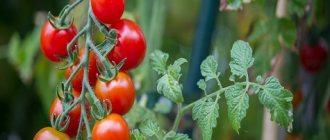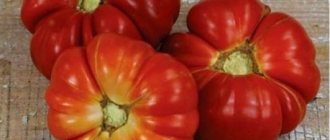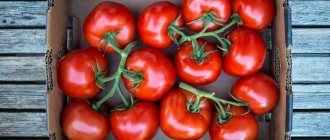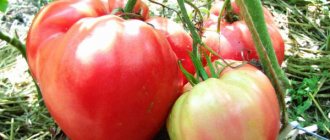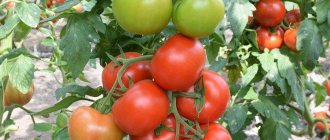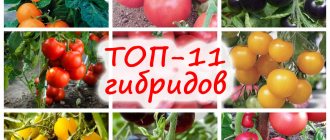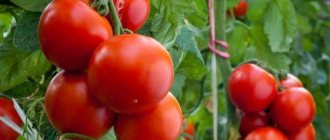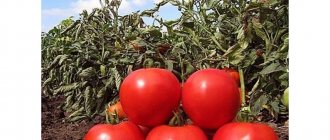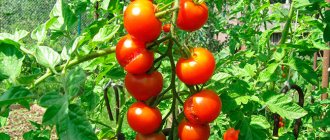| Ripening period: | average |
| Shape, weight of fruits: | truncated heart-shaped, 200-400 g, maximum – 1.5 kg |
| Bush type: | determinant |
| Growing regions: | everywhere |
| Productivity: | 6 kg per sq. m |
Lovers of sweet beef will surely love the Pink Honey tomato. It does not become sour even in cool cloudy summers; the photo of the cut fruit shows that there is only meat, almost no liquid and seeds. Productivity is high regardless of the weather, the tomatoes are very large without rationing - a real advantage. It is not surprising that the cultivar of Siberian selection quickly fell in love with Russian gardeners.
Description and characteristics of the variety
The tomato variety Pink Honey has been in the State Register since 2006. Its appearance is due to agro, the originator is O. V. Postnikova. It is recommended for cultivation in open ground and film greenhouses in all regions.
Have you already planted a Pink Honey tomato?
Yes
58.82%
No
41.18%
Description of the bush
The height of the Pink Honey tomato was declared by the breeder as 60-70 cm. But those who planted the variety claim that it tends to stretch. In the garden, under favorable conditions, it can reach 80-100 cm, and in permanent greenhouses - 1.5 m. It is possible that the owners themselves make mistakes, for example, they are zealous with nitrogen, but there are many such reviews.
Rose Honey does not have a very powerful bush. The stems cannot be called frail, but they cannot withstand the weight of the fruit. The leaves are thin, sparse, green, of medium size. In hot weather or when there is a lack of moisture, they are folded into a boat.
Fruit characteristics
According to the description of the State Register, Pink Honey tomatoes are round and ribbed; Siberian Garden calls them truncated heart-shaped. Gardeners who grow tomatoes every year note that even on the same bush, the fruits can sometimes differ, and to the described forms a heart-shaped one with a noticeably elongated lower part is added.
There is no need to say that the cultivar has not established itself - it is more than 15 years old. Re-grading is excluded by the presence of distinctive features of Rose honey:
- multi-chamber;
- Inside there is solid meat, almost no seeds;
- the taste is without sourness, even in a cool rainy summer it is bland-sweet, but when sunny it becomes honey-like;
- very thin skin;
- varietal characteristic - pink color with a moiré tint; if you look closely, the surface is covered with small matte whitish dots, giving an interesting effect;
- at the technical stage, the tomatoes are light green, with a dark spot at the tail - this is the last to be colored when ripe.
The fruits are collected in clusters of 3-6 pieces. This is a typical beef, without rationing, the lower tomatoes can reach 400 g, individual tomatoes when grown in 1 trunk - 700 g. The upper tomatoes are smaller, but also of a decent size - about 160-200 g.
If you set a goal and leave a few ovaries on the bush, Pink Honey tomatoes can be grown gigantic - 1-1.5 kg each.
Fruiting and productivity
The variety produces a harvest in medium terms. From full germination to the first colored tomatoes – 110-120 days. Brushes are tied starting from 6-7 leaves. If topping is not done in time, they will appear before frost.
To ensure that the lower tomatoes reach 700 g, and the upper ones are not smaller than 200 g, it is recommended to leave 4-5 brushes on the bush and pinch the ends.
In open ground, with good care of tomatoes from 1 sq. m harvest about 6 kg. In greenhouses - more, especially if they plant compactly and plant in 1 stem.
Giant fruits
The first inflorescence appears after 7-9 leaves. There are from 3 to 9-10 ovaries in the hand. The first tomatoes are large, about a kilogram or more, subsequent fruits are 600-800 grams each. The weight is determined by the growing conditions of the tomato and the correct agricultural technology. So, to increase the number of ovaries, it is recommended to form a bush into two stems, but the fruits will be smaller.
To obtain large tomatoes, only the main stem is left, the side shoots are removed. The tomato is characterized by excellent taste: aromatic, meaty. The shape is heart-shaped, slightly elongated. Slight ribbing is possible, although gardeners note that it is rare.
The skin is thin, bright pink in color, the flesh is juicy and has a sweet taste. There is no sourness. The fruits are multi-chambered and have few seeds. Pink honey tomatoes are prone to cracking and have low shelf life. They are recommended for immediate processing (juices, sauces) and for fresh consumption.
Due to their large size and fleshiness, the fruits of this variety are not suitable for preservation. But, judging by the reviews, housewives praise their taste in lecho, adjika, and all kinds of preparations for the winter (salads, dressings).
Features of cultivation and care
Rose honey seeds are planted 50-60 days before moving into the ground. Exact times vary depending on region and weather forecast. By the time of planting, the threat of return frosts should have passed, the ground should warm up to 15° C. In the northern regions, it is recommended to keep film or non-woven material on hand for the first time to protect the bushes in case of cold weather.
Seed preparation
The seed manufacturer recommends using stimulants, although gardeners do not complain about poor germination. Mandatory procedures before sowing:
- warming up for 20 minutes at a temperature close to 53° C;
- pickling;
- embryo stimulation;
- soaking until swelling.
Sparging, germination, hardening of tomato seeds and other additional operations - at the request of gardeners. There is no special need for them for high-quality planting material. Seeds treated by the manufacturer (coated, encrusted) are planted dry.
Growing seedlings
Tomato seeds are sown at 1-1.5 cm, laid out every 1-2 cm. The interval between rows is 4 cm. The substrate is moistened with a spray bottle and covered with film or glass. Germinate at 23-25° C.
When seedlings emerge, they are taken to a cool place. They are illuminated around the clock to avoid stretching of the subcotyledon - Rose Honey seedlings especially often suffer from this deficiency.
After a week, the tomatoes are returned to a warm (20-22° C) room. Additional lighting is reduced to 12-14 hours.
They dive in the phase of 2-3 true leaves. It is recommended to immediately bury the seedlings along the cotyledons.
After 10-14 days they begin to feed. There should be enough nitrogen in fertilizers to ensure the growth of green mass, despite the tendency to stretch. Growth is regulated:
- phosphorus and potassium fertilizers;
- a decrease in temperature to 18-20° C during the day, at night – 10-12° C;
- increasing lighting intensity.
Some gardeners leave stretching seedlings under lamps around the clock. This is absolutely impossible to do - the tomatoes will be weak, at night they not only rest, but also absorb the substances accumulated during the day, the products of photosynthesis.
2 weeks before planting, the seedlings are hardened off. First, keep in the fresh air for 20 minutes, then the time is gradually increased. The last nights, tomatoes should spend the night on the street or on an open balcony.
Transplantation and further care
Recommended density – 3 plants per 1 sq. m. They carry pink honey into 2-3 trunks. In a greenhouse, compact planting and formation into 1 stem are possible.
Standard care:
- moderate regular watering;
- after extending the second brush, calcium, phosphorus and potassium should predominate in the fertilizing;
- bush garter;
- loosening or mulching beds;
- removing excess shoots and leaves under the bunch that has begun to fill.
Particular attention should be paid to attaching fruit clusters. They are too heavy for a weak bush and break off easily. The bunches need to be tied to a support. It is convenient to do this on a trellis; a horizontal crossbar should be attached to the vertical pole.
Advantages and disadvantages
Based on the characteristics of the tomato and the experience of growing it by amateur vegetable growers, several conclusions can be drawn about the advantages and disadvantages of this variety. Pink honey features:
- productivity and large-fruitedness;
- wonderful taste of fruits;
- unusual appearance;
- belonging to the variety makes it possible to grow it from your own seeds, so you don’t have to look for them in the store every year.
The disadvantages of these tomatoes include:
- limited possibilities for using fruits;
- the tendency of all pink tomatoes to develop blossom end rot.
- the need for regular care to obtain high yields.
The variety is of interest only to amateur gardeners; it has no industrial significance.
Similar varieties
According to the characteristics and description of the Pink Honey variety, it is similar to beef tomatoes:
- Favorite holiday. Mid-season, determinant, selection - agro, in the State Register since 2008. Bush about 80 cm high, for open ground. The fruits are multi-chambered, fleshy, sweet, with an average weight of 350 g, with normalized ovaries - up to 1.3 kg. The shape is heart-shaped, the color is deep pink. Commercial tomatoes per sq. m gives 7.5 kg.
- Pudovik has been in the State Register since 2007, presented as indeterminate. The breeder claims that the variety is determinate, 1-1.5 m high, depending on the place of cultivation. Tomatoes are ribbed, heart-shaped, multi-chambered, raspberry-colored, sweet, fleshy. Average weight - 300 g, with normalization of ovaries - up to 1.5 kg. Productivity per bush – 5 kg, sq. m gives 15.5 kg.
- Eagle heart. Adopted by the State Register in 2005, the originator is the director V. N. Dederko. On the company’s website it is listed as an amateur variety. Mid-season, determinate, intended for private gardens and small farmers. Tomatoes are heart-shaped, pink-raspberry, weighing up to 400 g. Productivity per square meter. m – 9-14 kg. High resistance to cracking and adverse factors was noted.
- Tomato Pink elephant. A mid-early cultivar with raspberry fruits weighing up to 400 g and a yield of up to 3 kg per bush. The plant is semi-determinate, suitable for growing in open and protected ground.
Tomato variety Pink Honey is a classic beef. Inside it has solid sweet pulp, the skin is so thin that it can be easily removed when fully ripe. It does not require special care, but does need gartering of fruit clusters.
How to deal with diseases and pests of the Pink Honey tomato variety
| Problem | Chemicals | Traditional methods |
| Apical rot |
|
|
| Brown spot (cladosporiosis) |
|
The methods must be alternated, using one of them every 7 days. |
| scoop |
|
|
| Gray rot |
| Dissolve 80 g of baking soda in 10 liters of baking water. Spray with a spray bottle. If signs reappear, perform a second procedure after 5-7 days. |
| Late blight |
| Grind fresh garlic (1 head) with the stem using a meat grinder and add hot water. After a day, dilute it in 10 liters of clean water and use it to spray the bush. Repeat the procedure every 14 days. |
Photo gallery of drugs for diseases and pests of the Pink Honey tomato variety:
From the top of rot From the top of rot From late blight, brown spot
From late blight, brown spot
From potato fly
From aphids, cutworms From cutworms From gray rot From late blight, gray rot
From late blight, alternaria, gray rot
From gray rot
From late blight
From late blight From rhizoctinia, late blight, scab
Harvest and storage
Rose Honey bushes most often give the impression of being somewhat weak due to their tall growth and small number of leaves. But, despite this, they are capable of producing fairly abundant harvests from each plant, amounting to up to 6 kilograms. You can collect fruits from August until the end of fruiting.
Important! At the end of the season, you need to remove all the plants from the garden, dig up the soil, and replace the place where the tomatoes are planted next year.
Since these tomatoes require quite a delicate attitude due to their thin skin and large size, they need to be collected carefully, placing them in boxes, preferably in one layer.
Tomatoes cannot be stored for a long time, so it is better to use them for their intended purpose immediately after harvesting.
Seedless growing method
The seedless method of growing tomatoes has its advantages
- plants do not waste time adapting after transplantation;
- they develop faster and are stronger than their indoor counterparts;
- Their root system is taprooted and goes deep into the ground, so tomatoes suffer less from drought.
In the middle zone, this method is suitable only for ultra-early ripening varieties, and even then they do not always have time to produce the entire harvest during the short summer. The southern regions are a different matter: the soil warms up to the 15 degrees required for sowing already in April. There is plenty of bright sunshine. Fruiting will begin in August and will continue throughout September and most of October. This is in open ground, but in a greenhouse, even if not heated, you can sow much earlier.
How to do it?
- Choose a bed that has not been inhabited by plants from the nightshade family for 3 years. It is best if pumpkins, onions or cabbage grew there last season. The sun should illuminate the garden bed all day.
- For autumn digging, add 2 tbsp. spoons of superphosphate, a glass of stove ash and a bucket of humus, all this - for 1 sq. m.
- In the spring, the soil is loosened, watered if necessary, holes are dug about 5 cm deep in increments of 40 cm, 2-3 seeds are placed in each hole and covered with soil.
- The plantings are covered with film. As soon as the shoots appear, it needs to be removed, plastic bottles filled with warm water should be placed between the rows and covered again with film.
- As soon as the tops of the plants begin to reach the shelter, it is removed.
Advice ! In extreme heat, plants need to be watered and ventilated.
Further care for plantings is the same as for planted seedlings.
Landing in the ground
For tomatoes to start growing immediately, it must be about 20 degrees outside. The soil should also warm up. If its temperature is below 15 degrees, the roots simply will not be able to absorb food. Even in the same region, this happens at different times, let alone different ones located hundreds or thousands of kilometers from each other. You'll have to check the weather forecast. If it is favorable, we proceed to planting.
On a cloudy day, holes are formed in the soil dug up in the fall (prepared in the same way as for growing tomatoes without seedlings) in a greenhouse or in a garden bed. Their depth is slightly greater than the length of the root system. The distance between the planting holes depends on the future formation of the Pink Honey tomato variety: when growing in 1 stem - 40x50 cm, in 2 - 50x60 cm. Each hole is enriched with a tbsp. a spoonful of simple superphosphate or a teaspoon - double and tbsp. a spoonful of ash, a handful of humus. After adding nutrition, before planting, mix the soil well and pour enough water into the hole to make mud. Plants are planted in it. The soil is mulched with straw or hay; aged sawdust or mown and dried grass without seeds are suitable.
If for some reason the seedlings have outgrown, they are planted not in holes, but in grooves - “lying down”. Lay the stem horizontally so that the top faces north. The lower leaves that are covered with soil must be removed. Plants planted in this way develop a powerful root system, but the fruiting period is slightly delayed.
Advice ! It would not be amiss to carry out prevention against fungal infections already at the planting stage and replace part of the water with a solution of phytosporin M - prepare according to the instructions.
Now the plants will need watering every other week. To help them take root better, cover the bushes with non-woven material.
